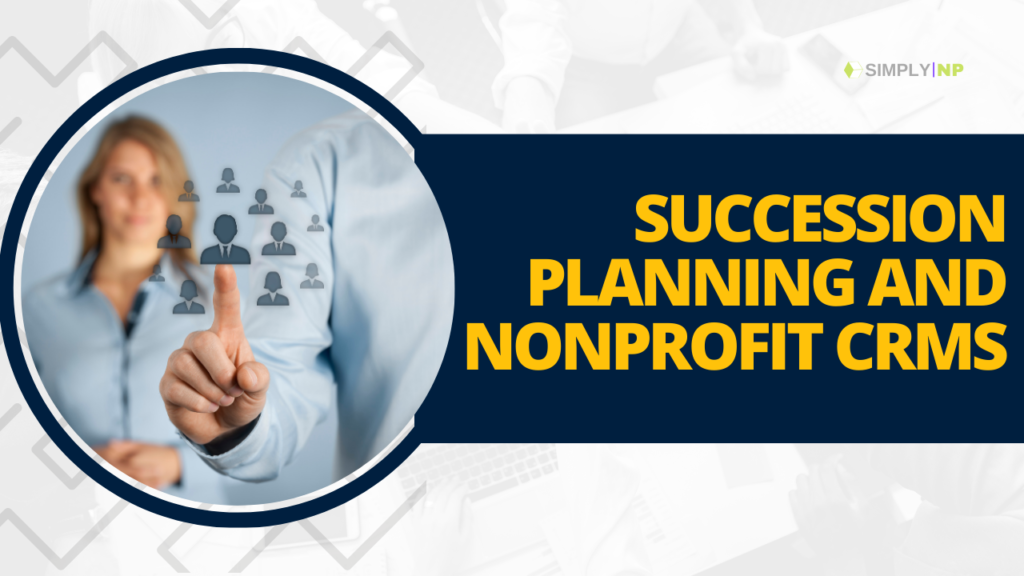
Succession planning is essential for nonprofits to ensure smooth leadership transitions, organizational stability and a proficient leadership pipeline.
Nonprofit organizations grapple with a multitude of challenges. In navigating these obstacles, nonprofit CRMs emerge as indispensable assets, harnessing their versatile functionalities to effectively tackle these issues. A significant hurdle is succession planning, a strategic process that involves identifying, developing, and nurturing individuals for key leadership roles. Succession planning is essential for nonprofits to ensure smooth leadership transitions, organizational stability and a proficient leadership pipeline. Nonprofit CRMs are instrumental in addressing this challenge. They help nonprofits by actively guiding them through skill and competency tracking, integrating employee performance metrics, overseeing training and development, implementing talent pool segmentation and conducting successor readiness assessment, along with succession pipeline visibility.
1. Skill and Competency Tracking
Skill and competency tracking is a systematic process that involves the continuous monitoring, assessment, and management of individuals’ skills, knowledge and behavioral attributes within the organization. This comprehensive approach encompasses the creation of individual skill profiles, ongoing evaluations, identification of skill gaps and integration with training initiatives.
Critical for succession planning, skill and competency tracking enables organizations to strategically nurture their talent pool, ensuring alignment with mission-critical objectives. By proactively developing a robust leadership pipeline, this approach enhances overall workforce effectiveness and resilience, providing adaptability and strength during periods of leadership change.
2. Employee Performance Metrics
Succession planning performance metrics involve various measurable indicators assessing an individual’s effectiveness, achievements and contributions in their current role. Examples of employee performance metrics include key performance indicators (KPIs), goal achievement, leadership competencies, project success and innovation, collaboration and teamwork, adaptability and learning agility.
Utilizing performance metrics for succession planning enhances the objectivity, effectiveness and strategic alignment of talent management initiatives. It ensures that decisions related to leadership development and succession are grounded in measurable achievements and outcomes, ultimately contributing to the long-term success of the organization.
3. Training and Development Tracking
Nonprofit CRMs serve as a centralized and efficient solution for training and development tracking. They establish individual training profiles, align with competency frameworks and directly connect learning initiatives to succession planning objectives. Through automated notifications, managerial oversight and integration with performance improvement plans, these systems ensure that training is precisely targeted. Feedback mechanisms and evaluation features provide invaluable insights while reporting and analytics tools facilitate decision-making driven by data.
Using training and development tracking for succession planning enhances the efficiency, effectiveness and strategic alignment of talent development initiatives, ensuring that employees are equipped with the necessary skills and competencies. This contribution supports the long-term success of the organization and fosters continuity in its leadership.
4. Talent Pool Segmentation
Talent pool segmentation within nonprofit CRMs is a strategic process that involves categorizing individuals based on specific criteria to identify and nurture potential leaders for key roles. Leveraging the features of nonprofit CRMs, organizations can customize segments based on skills, competencies and leadership potential.
This approach not only promotes a methodical framework for talent development but also enables ongoing monitoring, facilitating adjustments in response to evolving organizational needs and shifting leadership dynamics. By ensuring a targeted and efficient development strategy aligned with organizational requirements, this method streamlines succession planning. Talent pool segmentation emerges as a crucial practice for nonprofits, fostering the creation of a resilient and diverse leadership succession.
5. Successor Readiness Assessment
Successor Readiness Assessment involves a thorough evaluation of individuals within the talent pool, gauging their preparedness for assuming pivotal leadership roles within the organization. Conducted by nonprofit CRMs, this process is both comprehensive and dynamic, considering competencies, performance metrics, alignment with organizational goals and potential leadership scenarios.
As a crucial element of succession planning, successor readiness assessment empowers organizations to strategically identify and groom individuals for leadership roles. By aligning talent development with organizational goals, it ensures a seamless transition of leadership when needed. This proactive approach enhances organizational resilience, minimizes disruptions and optimizes investments in talent development for long-term success.
6. Succession Pipeline Visibility
Succession Pipeline Visibility is the ability to have a clear and comprehensive overview of the entire succession pipeline within an organization. This includes insights into individuals at various stages of readiness, from identification and development to potential placement in key leadership roles.
Within nonprofit CRMs, succession visibility is a strategic tool that empowers organizations to proactively manage their talent, optimize training efforts and make informed decisions regarding leadership development. Aligned with organizational goals, it promotes diversity and ensures that succession planning remains agile and responsive to the dynamic needs of the nonprofit sector.
Conclusion
Nonprofit CRMs play a crucial role in fortifying succession planning. The process initiates with skill and competency tracking, followed by the integration of employee performance metrics. Subsequent steps include training and development tracking, enabling talent pool segmentation. Successor readiness assessment marks the final stage before achieving succession pipeline visibility.
These deliberate actions together establish a resilient leadership structure, guide informed decision-making, cultivate a skilled workforce and foster a diverse pool of talent. This comprehensive approach positions nonprofits for lasting success by prioritizing their most valuable asset, their people. Essentially, nonprofit CRMs (such as SimplyNP) play a facilitating role, directing organizational excellence in the dynamic landscape of succession planning for the leaders of tomorrow.